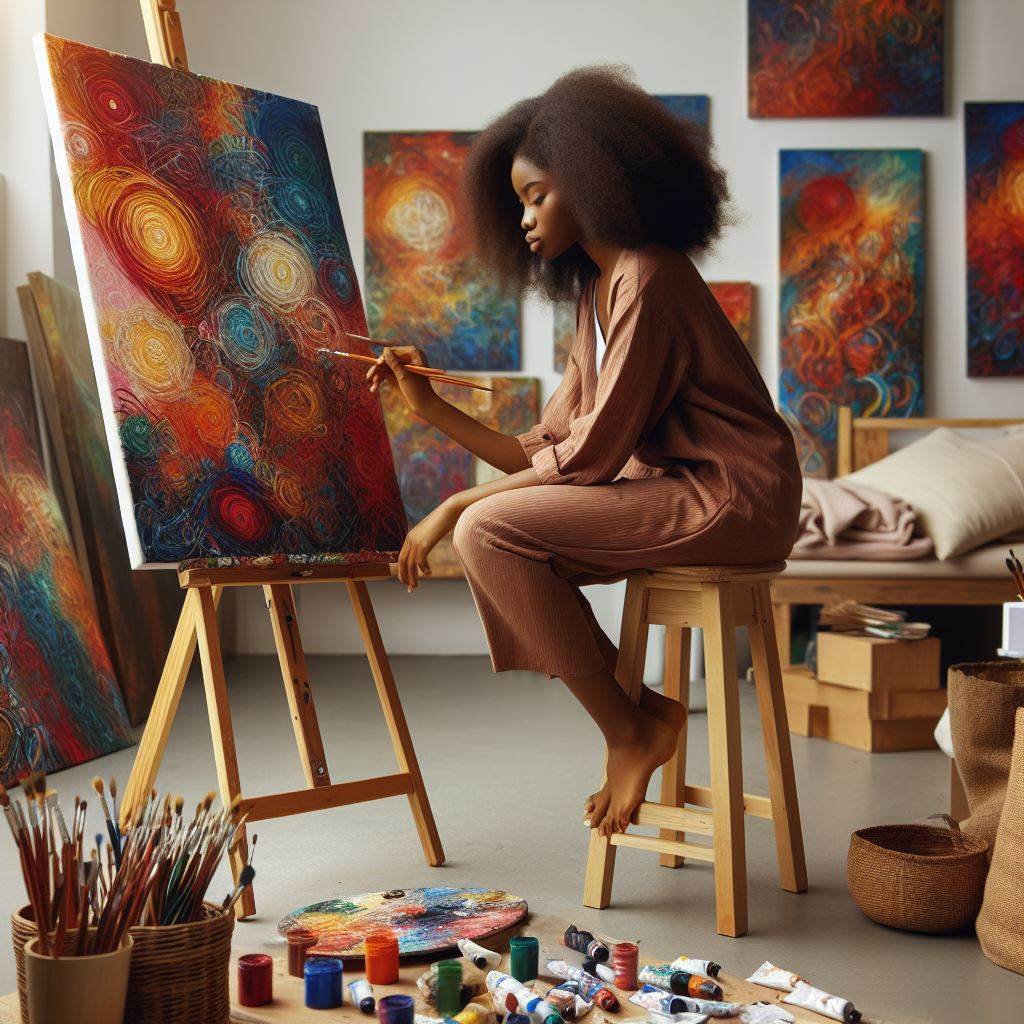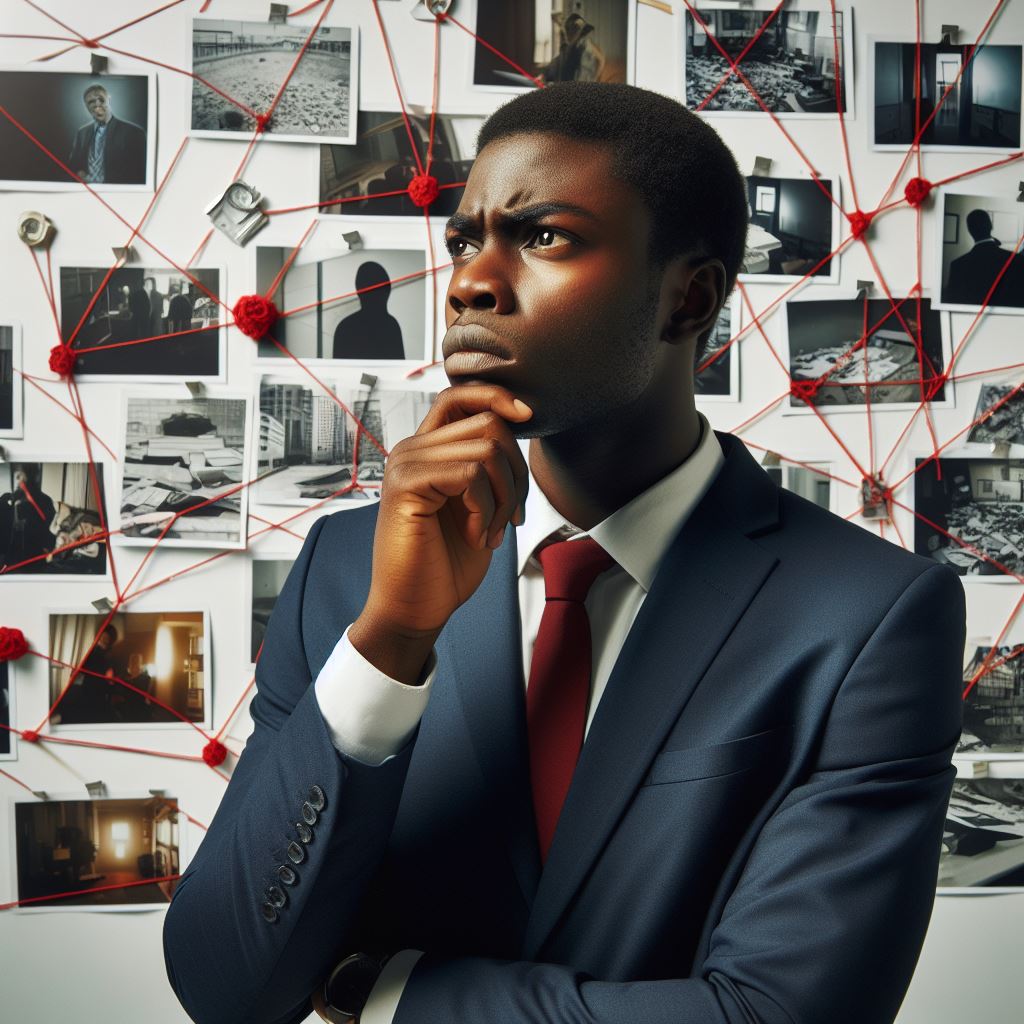Introduction
Art collaborations in the Nigerian creative space serve as dynamic catalysts for innovation and creativity, propelling the nation’s artistic community into new realms of expression and exploration.
By bringing together talents from various disciplines and backgrounds, these collaborations transcend boundaries, fostering a rich tapestry of artistic exchange and dialogue.
The importance of such collaborations cannot be overstated.
They serve as fertile grounds for the cross-pollination of ideas, sparking fresh perspectives and pushing the boundaries of traditional artistic practices.
Through collaborative endeavors, artists are able to draw inspiration from one another, experiment with new techniques, and collectively explore the intersections of culture, identity, and societal issues.
Nigeria’s artistic community is renowned for its diversity and vibrancy, with creatives hailing from diverse ethnic, cultural, and socioeconomic backgrounds.
This rich tapestry of talent fuels a dynamic ecosystem of artistic expression, where collaborations serve as powerful vehicles for amplifying voices, sharing stories, and building bridges across communities.
Types of Art Collaborations
Different Types of Collaborations
In the dynamic landscape of Nigerian creativity, various collaborative models thrive, offering avenues for innovation and expression.
Cross-disciplinary collaborations stand at the forefront, bringing together artists, musicians, writers, and performers to weave intricate tapestries of creativity.
These collaborations transcend traditional boundaries, blending diverse talents and perspectives to create immersive and multidimensional experiences that captivate audiences and challenge artistic norms.
Artist collaborations represent another pillar of the Nigerian creative ecosystem, where individual creators join forces to merge their unique styles and visions.
These partnerships result in dynamic works of art that push the boundaries of traditional practices, fostering experimentation and pushing the boundaries of artistic expression.
Furthermore, collaborations between artists and brands have become increasingly prevalent, providing opportunities for artists to showcase their work on commercial platforms while also allowing brands to tap into the authenticity and creativity of the artistic community.
These partnerships not only offer exposure and financial support to artists but also enhance brand identity and engagement with consumers.
Contributions to Industry Growth
The impact of these collaborations on the growth of the Nigerian art industry cannot be overstated.
By fostering cross-pollination of ideas and skills, they fuel a culture of innovation and experimentation, driving the industry forward and positioning Nigeria as a hub of artistic excellence.
Cross-disciplinary partnerships, by merging different art forms and disciplines, inspire new ways of thinking and create opportunities for artistic exploration.
They push the boundaries of creativity and challenge established norms, driving the evolution of Nigerian art.
Artist collaborations, on the other hand, amplify voices and perspectives, enriching the artistic landscape with diverse narratives and styles.
They provide opportunities for artists to collaborate, learn from one another, and push each other to new heights of creativity.
Collaborations with brands offer artists exposure to new audiences and resources, providing financial support and opportunities for growth.
This symbiotic relationship benefits both parties, contributing to the commercialization of art and the expansion of the industry as a whole.
Basically, collaborations within the Nigerian creative space play a vital role in driving industry growth, fostering innovation, and promoting artistic excellence.
By embracing collaboration and embracing diverse perspectives, Nigeria’s art industry continues to thrive and evolve, cementing its place on the global stage.
Read: Communication Arts: Balancing Theory and Practice
Benefits of Art Collaborations
Outlining the Benefits of Art Collaborations
Art collaborations offer a plethora of benefits, enriching the creative process and fostering growth within the artistic community.
Firstly, they provide artists with the invaluable opportunity to learn from one another, exchanging ideas, techniques, and insights that inspire new ways of thinking and creating.
Moreover, collaborations expose artists to new techniques, mediums, and perspectives, expanding their artistic repertoire and pushing the boundaries of their creativity.
This exposure to diverse influences encourages experimentation and innovation, leading to the development of fresh and dynamic artistic expressions.
Furthermore, collaborations offer artists the potential for increased visibility and recognition within the art world.
By partnering with other creatives or collaborating with brands and organizations, artists can amplify their reach and connect with broader audiences, thereby enhancing their professional profiles and opportunities for success.
The Development of Unique and Innovative Art Projects
Collaborations often serve as catalysts for the development of unique and innovative art projects.
By bringing together talents from different backgrounds and disciplines, collaborations facilitate the synthesis of diverse ideas and perspectives, resulting in works of art that are truly one-of-a-kind.
These collaborative projects encourage artists to think outside the box, experiment with new concepts and approaches, and push the boundaries of their artistic practice.
The collaborative process fosters a spirit of exploration and risk-taking, leading to the creation of art that is both innovative and impactful.
Moreover, collaborations provide a platform for artists to explore interdisciplinary connections and interdisciplinary connections, allowing them to draw inspiration from various sources and disciplines.
This interdisciplinary approach often results in projects that defy categorization and blur the lines between different artistic genres, offering audiences a fresh and immersive experience.
In essence, art collaborations offer artists a wealth of benefits, from learning and exposure to increased visibility and recognition.
By fostering collaboration and embracing diverse perspectives, artists can unlock new possibilities and push the boundaries of their creativity, leading to the development of unique and innovative art projects that captivate and inspire audiences.
Read: How to Apply for Communication Arts Programs
Challenges in Art Collaborations
Addressing Challenges in Art Collaborations
While art collaborations hold immense potential, they are not without hurdles.
Artists may grapple with differing artistic visions, stemming from diverse backgrounds and perspectives.
These disparities can lead to conflicts and hinder the cohesive execution of a project.
Communication breakdowns pose another challenge, especially in multi-disciplinary collaborations where conveying ideas across different mediums and languages can be complex.
Additionally, logistical obstacles such as scheduling conflicts, budget constraints, and access to resources may impede the smooth progress of collaborative endeavors.
Offering Solutions for Successful Collaborations
To navigate these challenges effectively, proactive communication is key.
Establishing a shared vision and clear objectives at the project’s onset fosters alignment and minimizes misunderstandings.
Regular check-ins and open dialogues provide opportunities to address any divergences in vision or concerns promptly, ensuring that all collaborators are on the same page.
Furthermore, strategic planning and resource allocation are crucial for overcoming logistical hurdles.
Developing a comprehensive project plan with realistic timelines, defined roles, and allocated resources enables efficient coordination and execution.
Flexibility and adaptability are also essential traits, allowing collaborators to navigate unexpected obstacles and adjust plans as needed.
Moreover, fostering a collaborative mindset and cultivating a culture of trust and respect among collaborators can mitigate conflicts and enhance teamwork.
Embracing diversity and valuing each other’s contributions fosters a sense of camaraderie and collective ownership, inspiring collaborators to work together towards a common goal harmoniously.
By implementing these strategies and maintaining open lines of communication, artists can overcome challenges and harness the full potential of collaborative endeavors.
Ultimately, successful art collaborations not only yield innovative and impactful outcomes but also foster a sense of community and camaraderie among artists, enriching the creative landscape as a whole.
Read: Famous Nigerian Alumni of Communication Arts Programs

Success Stories
Showcasing Successful Art Collaborations
Within the Nigerian creative space, numerous successful art collaborations have flourished, inspiring innovation and pushing boundaries.
One notable example is the collaboration between renowned visual artist, Nike Davies-Okundaye, and award-winning photographer, TY Bello.
Their collaborative project, “Identity”, explored themes of culture, heritage, and identity through a series of striking photographs and mixed-media artworks.
The project garnered widespread acclaim for its powerful imagery and thought-provoking narratives, showcasing the rich cultural tapestry of Nigeria to audiences worldwide.
Another impactful collaboration is the partnership between contemporary dancer Qudus Onikeku and visual artist Victor Ehikhamenor.
Their interdisciplinary project, “Reimagining Spaces”, combined dance performances with immersive art installations, blurring the lines between movement and visual art.
The collaboration sparked conversations about the intersection of dance and visual culture, challenging audiences to rethink their perceptions of space and movement.
The Impact
These collaborations have had a profound impact on the artists involved, providing opportunities for creative exploration and collaboration.
For Nike Davies-Okundaye and TY Bello, their collaboration allowed them to merge their respective artistic talents and perspectives, resulting in a body of work that resonated deeply with audiences and sparked conversations about cultural identity and representation.
Similarly, Qudus Onikeku and Victor Ehikhamenor’s collaboration pushed the boundaries of their respective art forms, challenging conventions and exploring new possibilities for artistic expression.
Their interdisciplinary approach opened up new avenues for creative exploration and collaboration, inspiring other artists to push the boundaries of their own practice.
Beyond the individual artists involved, these collaborations have also had a significant impact on the broader artistic community in Nigeria.
They have sparked conversations about the power of collaboration and interdisciplinary exchange, encouraging other artists to explore new ways of working and collaborating across disciplines.
Moreover, these collaborations have helped to showcase the richness and diversity of Nigerian art and culture to audiences both locally and internationally, contributing to the country’s growing reputation as a hub of artistic excellence.
Essentially, successful art collaborations within the Nigerian creative space have had a transformative impact on the artists involved and the broader artistic community.
By pushing boundaries, sparking conversations, and showcasing the richness of Nigerian art and culture, these collaborations have inspired innovation and creativity, shaping the landscape of Nigerian art for years to come.
Read: Impact of Communication Arts on Nigerian Media
Discover More: How Political Studies Shape Nigerian Electoral Processes
See Related Content: Alumni Success Stories from Nigerian Music Schools
Uncover the Details: Textile and Fashion Design in Nigerian Art
Collaboration Platforms
Identifying Platforms and Organizations
Numerous platforms and organizations in Nigeria actively support and facilitate art collaborations, fostering a thriving creative ecosystem.
One prominent example is the African Artists’ Foundation (AAF), which hosts artist residencies, workshops, and exhibitions.
Through its programs, AAF provides artists with opportunities to collaborate, learn from one another, and showcase their work to diverse audiences.
Another key player is the National Gallery of Art (NGA), which organizes exhibitions and events that bring together artists from across Nigeria and beyond.
These initiatives serve as platforms for collaboration, allowing artists to exchange ideas, exhibit their work, and engage with the public.
Discussing Their Role
These platforms play a crucial role in promoting collaboration and nurturing talent in the Nigerian art scene.
By providing spaces for artists to connect and collaborate, they foster a sense of community and camaraderie within the artistic community.
Moreover, platforms like AAF and NGA offer resources and support to artists, helping them develop their skills, expand their networks, and reach new audiences.
Through workshops, residencies, and exhibitions, artists gain exposure, feedback, and opportunities for professional development.
Furthermore, these platforms serve as catalysts for innovation and creativity, inspiring artists to push the boundaries of their practice and explore new ideas and techniques.
By bringing together artists from diverse backgrounds and disciplines, they encourage cross-pollination of ideas and perspectives, leading to dynamic and impactful collaborations.
In addition to supporting individual artists, these platforms contribute to the growth and vibrancy of the Nigerian art scene as a whole.
By showcasing the work of emerging and established artists, they raise the profile of Nigerian art both nationally and internationally, attracting attention and investment to the country’s artistic community.
Generally, platforms and organizations that support art collaborations play a vital role in fostering creativity, innovation, and community in the Nigerian art scene.
By providing opportunities for artists to connect, collaborate, and showcase their work, they contribute to the growth and development of Nigeria’s vibrant artistic ecosystem.
You Might Also Like: Economics Internship Opportunities in Nigeria
Delve into the Subject: Importance of Security Studies in Nigeria Today
See Related Content: How Technology is Shaping Nigerian Art
See Related Content: Anthropological Perspectives on Nigerian Migration
Future Trends
Predicting Future Trends
Art collaborations in the Nigerian creative space are poised to evolve in response to emerging trends and technological advancements.
One anticipated trend is the rise of increased digital collaborations, fueled by the growing accessibility of digital tools and platforms.
Artists will leverage digital technologies to collaborate remotely, transcending geographical boundaries and fostering global connections.
Another trend is the proliferation of virtual exhibitions, driven by the demand for immersive and accessible art experiences.
Virtual platforms will enable artists to showcase their work to global audiences, democratizing access to art and expanding the reach of Nigerian artists beyond traditional gallery spaces.
Moreover, collaborative projects addressing social issues are expected to gain traction, reflecting a growing desire among artists to engage with pressing societal issues and effect positive change.
Collaborations between artists, activists, and community organizations will harness the power of art to raise awareness, provoke dialogue, and inspire action on issues such as social justice, environmental sustainability, and cultural identity.
Considering Impact
These trends have the potential to significantly impact the local art industry and artistic community in Nigeria.
Increased digital collaborations will democratize access to artistic opportunities, allowing artists from diverse backgrounds to collaborate and share their work on a global scale.
Virtual exhibitions will provide Nigerian artists with greater visibility and exposure, connecting them with audiences from around the world and expanding their market reach.
This increased visibility will attract investment and support for the local art industry, stimulating economic growth and cultural exchange.
Furthermore, collaborative projects addressing social issues will position Nigerian artists as agents of change, driving meaningful dialogue and advocacy on important societal issues.
By amplifying marginalized voices and shedding light on pressing social issues, these collaborations will foster empathy, understanding, and social cohesion within the artistic community and beyond.
Therefore, the future of art collaborations in the Nigerian creative space holds immense potential for innovation, connectivity, and social impact.
By embracing emerging trends and leveraging digital technologies, Nigerian artists will continue to push the boundaries of artistic expression, inspire change, and shape the future of the local art industry and artistic community.
Gain More Insights: Music School Fees in Nigeria: What to Expect
Explore Further: Teaching History & Strategic Studies in Nigerian Schools
You Might Also Like: Careers with a Degree in Christian Religious Studies
Conclusion
Art collaborations play a vital role in the Nigerian creative space, fostering a sense of community and unity among artists.
By working together, artists can combine their unique talents and perspectives to create innovative and impactful pieces of art.
Through collaborations, artists have the opportunity to learn from one another, share resources, and expand their artistic horizons.
This collective effort not only benefits the artists involved but also contributes to the growth and development of the Nigerian art scene as a whole.
It is essential for artists to actively seek out collaborative opportunities and continue to push boundaries in their artistic practice.
By collaborating with fellow artists, creators can break free from the limitations of individual perspectives and explore new ideas and techniques.
Ultimately, art collaborations in the Nigerian creative space help to build a supportive and enriching environment where artists can thrive and create meaningful work that resonates with audiences.
The power of collaboration in art cannot be understated, as it has the potential to inspire, provoke thought, and drive positive change in society.




